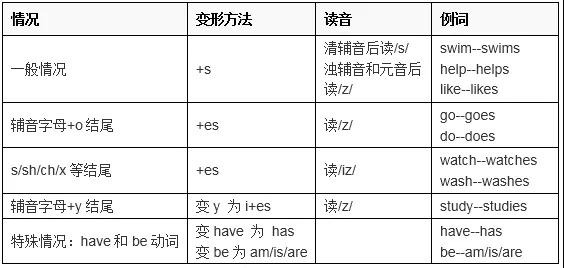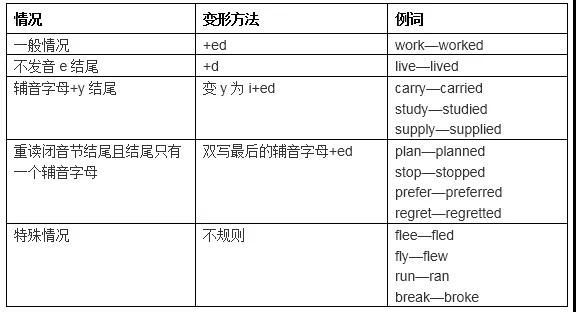备战期末|初中英语必考的八大时态结构及用法详解
http://www.newdu.com 2025/12/13 10:12:52 三好网 佚名 参加讨论
时态无疑是初中英语最重要的语法内容,学好时态基本就拿下了语法的半壁江山。今天资深英语老师总结的八种时态是大家在初中阶段必学必考的,期末复习时一定要加倍重视! 英语八大时态:  一,一般现在时 标志:动词原形  1.表示经常性或习惯性动作,常与表频度的时间状语连用: SheoftenspeaksEnglish. Ileavehomeforschoolat7everymorning. 2.表示现在的状态、特征、职业、能力、感觉等: Heseemstofeelabitdowntoday. Heworksasadriver. 3.表示真理、客观存在、科学事实或用于格言警句中: ShanghailiesintheeastofChina. Columbusprovedthattheearthisround. Wherethereisawill,thereisaway. 4.表示现在瞬间的动作: Herecomesthebus! 5.表示将来 1)表按规定、计划、安排将要发生的动作(仅限于某些表示“来、去、动、停、开始、结束、继续”等的趋向动词),可以与表示未来的时间状语搭配使用。常见的用法是:飞机、火车、轮船、汽车等定期定点运行的交通状况。如: Thenexttrainleavesat3o’clockthisafternoon. Howoftendoestheshuttlebusrun? 2)在时间和条件状语从句中常使用一般现在时表示将来发生的事情: WhenBillcomes(不用willcome),askhimtowaitforme. IshallgotheretomorrowunlessI’mtoobusy. 二,一般过去时 标志:动词过去式  *闭音节:元音字母a,e,i,o,u如果发字母本来的音则称为开音节,否则称为闭音节。 1.表示过去某时所发生的动作或存在的状态,常与表示过去的时间状语连用(e.g.yesterday,thismorning,justnow,amomentago,inMay,lastnight/year/week,onceuponatime,theotherday,before…,when…,inthepast等)。如: Jimrangyoujustnow. LiuYingwasinAmericalastyear. 2.表示过去经常或反复发生的动作,特别是usedtodo表达的句型,本身表示的就是过去常常。如: WhenIwasakid,Ioftenplayedfootballinthestreet. Sheusedtovisithermotheronceaweek. *注意区分sb.usedtodosth.(某人过去常常做某事,此处to是动词不定式标志符号)和sb.beusedtosth./doingsth.(某人习惯于某物/做某事,此处to是介词)。 3.代替一般现在时,表示一种婉转、客气、礼貌、商量的语气。此用法仅适用于少数动词(如want,hope,wonder,think,intend等)及情态动词could,would。如: Iwonderedifyoucouldhaveawordwithme. IhopedyoucouldhelpmewithmyEnglish. Wouldyoumindmysittinghere? 4.虚拟语气中用一般过去时表示现在或将来时间的动作或状态。常用句型有: Itistimethatsb.didsth.“某人该做某事了” wouldrathersb.didsth.“宁愿某人做某事” 三,一般将来时 标志:will/shall+动词原形 1.表示将来发生的动作或存在的状态,通常与表示将来的时间状语连用(e.g.tomorrow,nextweek,inthefuture等)。如: Weshallhavealotofrainnextmonth. Myhusbandwillcomebackinafewdays. 2.表示倾向性和习惯性: Fishwilldiewithoutwater. Whenitgetswarmer,thesnowwillstarttomelt. 3.一般将来时的几种句式结构辨析: 1)will/shall+动词原形 多用于表达主观愿望或必定会发生的事情(“将会如何”) *shall作助动词时一般只用于第一人称 2)begoingto+动词原形 表示即将发生或打算要做的事: Itisgoingtorain. Wearegoingtohaveameetingtoday. 3)beto+动词原形 表示按计划或安排即将要发生的动作: HeistovisitJapannextyear. WearetodiscussthereportonMonday. 4)beaboutto+动词原形 表示即将发生的动作,意为“马上要做某事”,后面一般不跟时间状语,如: Theplaneisabouttostart. Don’tworry.Iamabouttomakeacloseexaminationonyou. 四,现在进行时 标志:be+动词的现在分词 1.表示说话时正在进行的动作: Sheiswritingaletterupstairs. Whoareyouwaitingfor? Itisraininghard. 2.表示现阶段一直在进行的动作(说话时动作未必正在进行): IhearMr.Greeniswritinganothernovel. 3.表示反复出现或习惯性的动作,往往包含说话者赞扬、责备、厌恶等情绪,通常与always,constantly,continually,forever等频度副词连用。如: Johnisforeveraskingsillyquestionslikeastupid. Heisalwaysthinkingofothersfirst. 4.表示将来 1)表示按计划、安排将要发生的动作,仅适用于部分趋向动词(如go,come,leave,start,arrive等)。如: UncleWangiscoming. They'releavingforBeijing. 2)在时间和条件状语从句中,现在进行时表示将来某时正在发生的事情。如: Pleasedropinwhenyouarepassingmyway. Ifheisstillsleeping,don’twakehimup. 五,过去进行时 标志:was/were+动词的现在分词 1.表示过去某一时刻或一段时间正在进行的动作,过去进行时中常用的时间状语有thewholemorning,alldayyesterday,fromJanuarytoMarchlastyear等。如: IwashavingatalkwithLucyatthattime. TheywerewatchingTVathomelastnight. 2.表示过去反复出现或习惯性的动作,往往包含说话者赞扬、责备、厌恶等情绪,通常与always,constantly,continually,forever等频度副词连用。如: Mybrotherwasalwayslosinghiskeys. 3.表示按计划、安排过去某时刻将要发生的动作,仅适用于部分趋向动词(如go,come,leave,start,arrive等)。如: HesaidtheywereleavingforBeijingthisafternoon. 4.过去进行时有一个主要用法就是描述一件事情发生的背景(一个长动作延续的时候,另一个短动作发生): Grannyfellasleepwhenshewasreading. Itwasrainingwhentheyleftthestation. 六,现在完成时 标志:have/has+动词的过去分词 1.表示一个过去发生并已完成的动作对现在产生影响或结果,强调的是现在的状况(表示“已完成”)。如: Hehasleftthecity.(结果:他目前不在这个城市) Someonehasbrokenthewindow.(结果:窗户破了) 2.表示一个动作开始于过去,持续到现在,也可能还会继续持续下去(表示“未完成”)。 Ihavebeenbusysincelastweek. Hehastaughtinourschoolfor30years. I’vefinishedhalfsofar. 注意瞬间动词通常是不能用现在完成时表持续性的,但其否定结构则可以。如: Shehasn’tseenyouforages. Hisfatherhasn’ttouchedbeerforawholeweek. 3.表示过去到现在为止反复发生的动作或多次出现的状态,常与表示频度的副词always,often,everyday等连用。如: Ihaveoftenheardthatheisthecleverestpersoninthatcompany. 4.在时间和条件状语从句中,现在完成时表示将来某时完成的动作。如: I’llgotoyourhomewhenIhavefinishedmyhomework. Ifithasstoppedsnowinginthemorning,we’llgothepark. 5.与现在完成时连用的常见词语 能与现在完成时连用的词语很多,just,already,yet,before,never,ever,recently等,但常见的有: 1)since自从 Ihavebeentheremanytimessincethewar. Wehaven’tseeneachothersincelastweek. Wehavebeenfriendseversince. 2)in/for/duringthepast/last…years在过去/最近…中 I’vebeenillforthepastthreeweeks. Greatchangeshavetakeplaceinthelasttenyears. Ihavebeenhere(for)thelast/pastmonth. 3)sofar到目前为止 Wehaven’thadanytroublesofar. Sofarthesearchforthemissingmiddle-agedwomanhasbeenfruitless. 4)upto/untilnow到现在为止 Uptonowhe’sbeenquiet. Uptonow,theworkhasbeeneasy. Ihaveheardnothingfromhimuptillnow. Uptillnowwehaveplantedover2000trees. 5)Itis/willbethefirst/second…timethat…这是第一/二…次… It’sthefirsttime(that)I’vebeenhere. Itwillbethefirsttime(that)I’vespokeninpublic. Itisthesecondtime(that)Ihavemethimtoday. 6)Thisis+形容词最高级+that…这是最… ThisisthebestfilmthatI’ve(ever)seen. 6.现在完成时与一般过去时的区别 1)现在完成时强调对现在的影响和结果,与现在有联系; 而一般过去时强调这个动作发生的时间是在过去,不涉及对现在的影响。如: Ihaveseenthisfilm.(我已经看过了这部电影) Isawthisfilmyesterday.(我是昨天看的这部电影) 2)现在完成时常与模糊的时间状语连用(如for,since,sofar,ever,never,just,yet,till/until,uptonow,always等),或者干脆没有时间状语; 而一般过去时常与具体的时间状语连用(如yesterday,lastnight,…ago,in1980,inFebruary等)。 3)现在完成时表示持续时一般使用延续性动词(如live,teach,work,know等); 而一般过去时常使用瞬间动词(如begin,buy,die,marry等)。如: HehaslivedinHangzhousincelastspring. Mygrandfatherboughtthecarfiveyearsago. 7.易错点辨析 1)考生容易把一些瞬间动词用现在完成时表达,这是错误的。如: (×)Hehasdiedfortwoyears.他死了两年了。 (√)Hehasbeendeadfortwoyears. (√)Hediedtwoyearsago. (×)Thefilmhasbegunfor10minutes.电影开演十分钟了。 (√)Thefilmhasbeenonfor10minutes. (√)Thefilmbegan10minutesago. (×)Shehasmarriedforthreeyears.她结婚有三年了。 (√)Shehasbeenmarriedforthreeyears. (√)ShemarriedMikethreeyearsago. 2)考生不懂如何区分havebeento和havegoneto,尽管两者均可后接地点,但havebeento表示去过某地(现在已经回来了),havegoneto表示到某地去了(现在还没回来)。如: ShehasbeentoParis(threetimes). ShehasgonetoParis. 七,过去完成时 标志:had+动词的过去分词 1.表示在过去的某个时间或动作以前已经发生的动作或已经存在的状态。如: Bytheendoflastweekhehadfinishedthework. HehadleftwhenIarrived. 2.表示从过去某一时间开始,一直延续到过去另一时间的动作或状态。如: WehadnotseeneachothersinceIleftBeijing. Thefilmhadbeenonfor5minuteswhenIgottothecinema. 3.某些表意向的动词(如intend,think,plan,expect,hope等)的过去完成时表示主语未曾实现的愿望、希望、打算。如: Ihadintendedtovisityoulastnight,butsomeonecalledandIcouldn’tgetaway. Wehadhopedthatyouwouldcome,butyoudidn’t. 4.(虚拟语气)在条件状体从句或wish/wouldrather等后面的从句中,使用过去完成时表示与过去事实相反的主观愿望。如: Thepartywouldn’thavebeensoperfectifyouhadn’tcome. IwishIhadgonewithyoutotheconcertthatday. 5.过去完成时与一般过去时 1)基本区别:过去完成时表示以过去某时间为起点以前所发生的动作或存在的状态,即过去完成时强调“过去的过去”,而一般过去时只表示以现在时间为起点以前所发生的事情或存在的状态。如: Hestudiedtheretwoyearsago.他两年前在那儿学习(离现在两年) Hesaidhehadstudiedtheretwoyearsbefore.他说他两年前在那儿学习过。(离他说话时两年) 2)特别注意:两个动作如果按顺序发生,又不强调先后,或者用then,and,but等连词连接时,多用一般过去时。如: Whenshesawthemouse,shescreamed. MyauntgavemeahatandIlostit. 八,过去将来时 标志:would+动词原形 1.表示从过去某一时间来看将要发生的动作或存在的状态,一般用于主句为过去时的宾语从句中。如: HesaidhewouldcomeherenextFriday. Iknewthathewouldhelpuswhenwewereintrouble. 2.表示过去的动作习惯或倾向: Theoldmanwouldsitonabenchinthequiteparkforhourswithoutdoinganything. WhenIworkedonthatfarm,Iwouldgetupat5am. 3.用于虚拟语气中: IfIwereyou,Iwouldnotdothat. Ifhewerehere,hewouldshowushowtodoit. 4.过去将来时的其他形式 1)was/weregoingto+动词原形。如: Hetoldusthathewasgoingtoattendthemeeting. ShesaidthatIwasgoingtobesenttomeetherattherailwaystation. 2)was/wereto+动词原形。如: Thebuildingwastobecompletednextmonth. LiLeiwastoarrivesoon. 3)was/wereaboutto+动词原形。如: Wewereabouttoleavetherewhenitbegantorainheavilyandsuddenly. Hewasabouttohavelunchwhenthebellrang. 声明: (责任编辑:admin) |